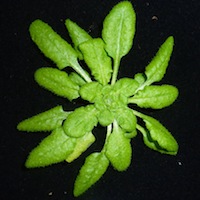James Lloyd (University of Leeds) was the lead author on last month’s Plant Journal paper on nonsense-mediated mRNA decay, which demonstrated that working on a model plant can sometimes be a hinderance rather than a help. In this guest post he explains how he and his supervisor Brendan Davies overturned widely held assumptions about NMD in plants – by working on moss.
Plant biology has been greatly advanced by the use of Arabidopsis thaliana as a model. Fantastic community resources, such as mutant collections and numerous genome sequences from natural accessions have aided researchers in all areas of plant sciences. However, A. thaliana is far from perfect. Nonsense-mediated mRNA decay (NMD) is a little heard of pathway to regulate transcript stability and it has recently been shown to be involved in pathogen response in A. thaliana (Rayson et al., 2012).
The mechanism of mRNA decay has largely been worked out in animals and revolves around the phosphorylation of an RNA helicase called UPF1 by a kinase SMG1. However, fungi and A. thaliana both lack the SMG1 kinase, so it has been a mystery how the fungal and plant proteins are phosphorylated. We have recently shown that SMG1 is not animal specific but is an ancient component of the NMD machinery, appearing in the genomes of all plants examined, with the exception of A. thaliana. SMG1 is even found in the genome of A. lyrata, a close relative of A. thaliana.
The lack of SMG1 in the genome of A. thaliana meant that we had to use another plant as our model to understand the role of SMG1 in the plant kingdom. Enter moss! Physcomitrella patens is the model moss, with a sequenced genome and a high rate of homologous recombination it is a relatively simple task to identify and delete any gene in the genome. The rate of homologous recombination is much lower in flowering plants than it is in moss, meaning that short (around 1 Kb) of moss genomic DNA from upstream and downstream of a gene of interest can be cloned around an antibiotic selection gene and then transformed into moss cells and a large proportion of antibiotic resistant plants have the gene of interest deleted.
We deleted SMG1 from moss and found that NMD was compromised thus placing plant SMG1 in the NMD pathway (Lloyd and Davies, 2013). Therefore, many plants including crops like rice and maize are likely to rely on SMG1 to control gene expression through NMD. Future research will hopefully reveal why A. thaliana has lost SMG1 and if another kinase has replaced SMG1 in this plant.
A. thaliana has been useful in characterising other components of the NMD pathway in plants, such as UPF1 and understanding the biological role in plants (such as controlling the pathogen response). However, it was limited in helping us understand the NMD pathway of commercially important crops and it was moss to the rescue!
Animal researchers have long used multiple, evolutionarily diverse models, including but not limited to fruit flies, C. elegans, zebrafish, frogs and mice. Despite big differences between invertebrates like fruit flies and vertebrates like humans, a great deal about human biology has been learnt by using these organisms in the lab.
Many important questions cannot be answered by simply studying A. thaliana, big differences in fundamental processes exist between accessions. Therefore, multiple models are needed in plant sciences. Moss is just one plant that can help compliment research in other plant species, using the powerful genetic tool of homologous recombination.
References:
Lloyd JPB and Davies B (2013) SMG1 is an ancient nonsense-mediated mRNA decay effector. The Plant Journal 1365-313X http://dx.doi.org/10.1111/tpj.12329
Rayson S, Arciga-Reyes L, Wootton L, De Torres Zabala M, Truman W, et al. (2012) A Role for Nonsense-Mediated mRNA Decay in Plants: Pathogen Responses Are Induced in Arabidopsis thaliana NMD Mutants. PLoS ONE 7(2): e31917. doi:10.1371/journal.pone.0031917
Images courtesy of James Lloyd.


